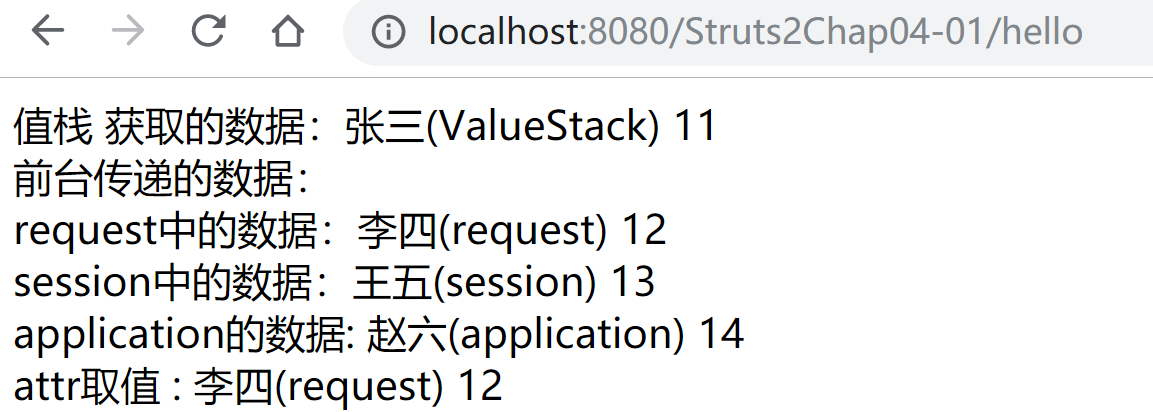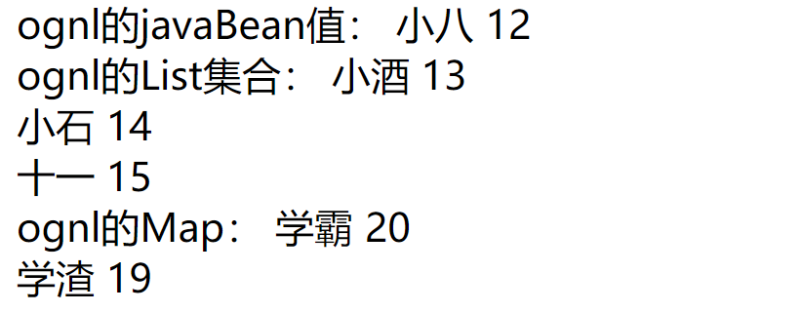Struts2的值栈和OGNL牛逼啊
Struts2的值栈和OGNL牛逼啊
一 值栈简介:
值栈是对应每个请求对象的一套内存数据的封装,Struts2会给每个请求创建一个新的值栈,值栈能够线程安全的为每个请求提供公共的数据存取服务。
二 OGNL介绍:
(1)基本数据:
OGNL 是对象图导航语言 Object-GraphNavigationLanguage 的缩写,它是一种功能强大的表达式语言。
OGNL 访问 ValueStack 数据 <s:propertyvalue=”account”/>
OGNL 访问 ActionContext 数据
访问某个范围下的数据要用#
#parameters 请求参数 request.getParameter(...);
#request 请求作用域中的数据 request.getAttribute(...);
#session 会话作用域中的数据 session.getAttribute(...);
#application 应用程序作用域中的数据 application.getAttribute(...);
#attr 按照 page request session application 顺序查找值
我们以例子理解这部分内容,设置HelloAction:
1 public class HelloAction extends ActionSupport{
2 private static final long serialVersionUID = 1L;
3 @Override
4 public String execute() throws Exception {
5 //狭义上的值栈
6 ActionContext actionContext=ActionContext.getContext();
7 ValueStack valueStack=actionContext.getValueStack();
8 valueStack.set("name", "张三(ValueStack)");
9 valueStack.set("age", 11);
10 //session中的值
11 Map<String, Object> session=actionContext.getSession();
12 session.put("name","王五(session)");
13 session.put("age","13");
14 //application中的内容
15 Map<String, Object> application=actionContext.getApplication();
16 application.put("name", "赵六(application)");
17 application.put("age","14");
18 return SUCCESS;
19 }
20 }
Struts.xml文件的配置:
1 <struts>
2 <constant name="struts.ognl.allowStaticMethodAccess" value="true"></constant>
3 <package name="manage" namespace="/" extends="struts-default">
4 <action name="hello" class="com.java1234.Action.HelloAction">
5 <result name="success" >success.jsp</result>
6 </action>
7 </package>
8 </struts>
前端页面success.jsp
1 <%@ page language="java" contentType="text/html; charset=utf-8"
2 pageEncoding="utf-8"%>
3 <%@taglib prefix="s" uri="/struts-tags" %>
4 <!DOCTYPE html PUBLIC "-//W3C//DTD HTML 4.01 Transitional//EN" "http://www.w3.org/TR/html4/loose.dtd">
5 <html>
6 <head>
7 <meta http-equiv="Content-Type" content="text/html; charset=utf-8">
8 <title>Insert title here</title>
9 </head>
10 <%
11 request.setAttribute("name", "李四(request)");
12 request.setAttribute("age", "12");
13 %>
14 <body>
15 值栈 获取的数据:<s:property value="name"/>
16 <s:property value="age"/>
17 <br/>
18 前台传递的数据:<s:property value="#parameters.name"/>
19 <s:property value="#parameters.age"/>
20 <br/>
21 request中的数据:<s:property value="#request.name"/>
22 <s:property value="#request.age"/>
23 <br/>
24 session中的数据:<s:property value="#session.name"/>
25 <s:property value="#session.age"/>
26 <br/>
27 application的数据: <s:property value="#application.name"/>
28 <s:property value="#application.age"/>
29 <br/>
30 attr取值 : <s:property value="#attr.name"/>
31 <s:property value="#attr.age"/>
32 <br/>
33 </body>
34 </html>
首先,是取值方式<s:property value="方式"/>,
①值栈 直接取 比如说是name age 就可以使用这种方式 value=”name” value=”age”
②page页面传递的数据 比如说是name age 使用这种方式 value="#parameters.name” value="#parameters.age”
③requset 设置的值 使用的方式 value="#request.name" value="#request.age"
④session设置的值使用的方式 value="#session.name" value="#session.age"
⑤application设置的值使用的方式 value="#application.name" value="#application.age"
之后attr的取值方式是按照 page request session applicaiton这个顺序取得。
例如:attr获取的是request的值

(2)OGNL 访问静态方法和属性
Mystatic类:
1 public class MyStatic {
2
3 public static final String str="yxs";
4
5 public static String printUrl(){
6
7 System.out.println("http://www.yxs.com");
8
9 return "http://www.yxs.com";
10
11 }
12
13 }
Static.jsp直接访问:
1 <body>
2 访问静态属性: <s:property value="@com.java1234.common.MyStatic@str"/><br/>
3 访问静态方法:<s:property value="@com.java1234.common.MyStatic@printUrl()"/>
4 </body>
结果:

(3)OGNL 访问复杂对象
我们以javaBean对象为例:Student类
1 public class Student {
2 private String name;
3 private int age;
4 public Student() {
5 super();
6 // TODO Auto-generated constructor stub
7 }
8 public Student(String name, int age) {
9 super();
10 this.name = name;
11 this.age = age;
12 }
13 public String getName() {
14 return name;
15 }
16 public void setName(String name) {
17 this.name = name;
18 }
19 public int getAge() {
20 return age;
21 }
22 public void setAge(int age) {
23 this.age = age;
24 }
25 }
Success.jsp文件:
1 <html>
2 <body>
3 ognl的javaBean值: <s:property value="student.name"/>
4 <s:property value="student.age"/>
5 <br/>
6 ognl的List集合: <s:property value="students[0].name"/>
7 <s:property value="students[0].age"/>
8 <br/>
9 <s:property value="students[1].name"/>
10 <s:property value="students[1].age"/>
11 <br/>
12 <s:property value="students[2].name"/>
13 <s:property value="students[2].age"/>
14 <br/>
15 ognl的Map: <s:property value="studentMap['goodStudent'].name"/>
16 <s:property value="studentMap['goodStudent'].age"/>
17 <br/>
18 <s:property value="studentMap['badStudent'].name"/>
19 <s:property value="studentMap['badStudent'].age"/>
20 <br/>
21 </body>
22 </html>
HelloAction文件代码:
1 public class HelloAction extends ActionSupport{
2 private static final long serialVersionUID = 1L;
3 private Student student;//javaBean
4 private List<Student>students;//list
5 private Map<String,Student>studentMap;//Map
6 public Student getStudent() {
7 return student;
8 }
9
10 public void setStudent(Student student) {
11 this.student = student;
12 }
13
14 public List<Student> getStudents() {
15 return students;
16 }
17
18 public void setStudents(List<Student> students) {
19 this.students = students;
20 }
21
22 public Map<String, Student> getStudentMap() {
23 return studentMap;
24 }
25
26 public void setStudentMap(Map<String, Student> studentMap) {
27 this.studentMap = studentMap;
28 }
29
30 @Override
31 public String execute() throws Exception {
32 // TODO Auto-generated method stub
33
34 students=new ArrayList<Student>();
35 student=new Student("小八",12);
36 students.add(new Student("小酒",13));
37 students.add(new Student("小石",14));
38 students.add(new Student("十一",15));
39 studentMap=new HashMap<String,Student>();
40 studentMap.put("goodStudent", new Student("学霸",20));
41 studentMap.put("badStudent", new Student("学渣",19));
42 return SUCCESS;
43 }
44 }
显示结果:


